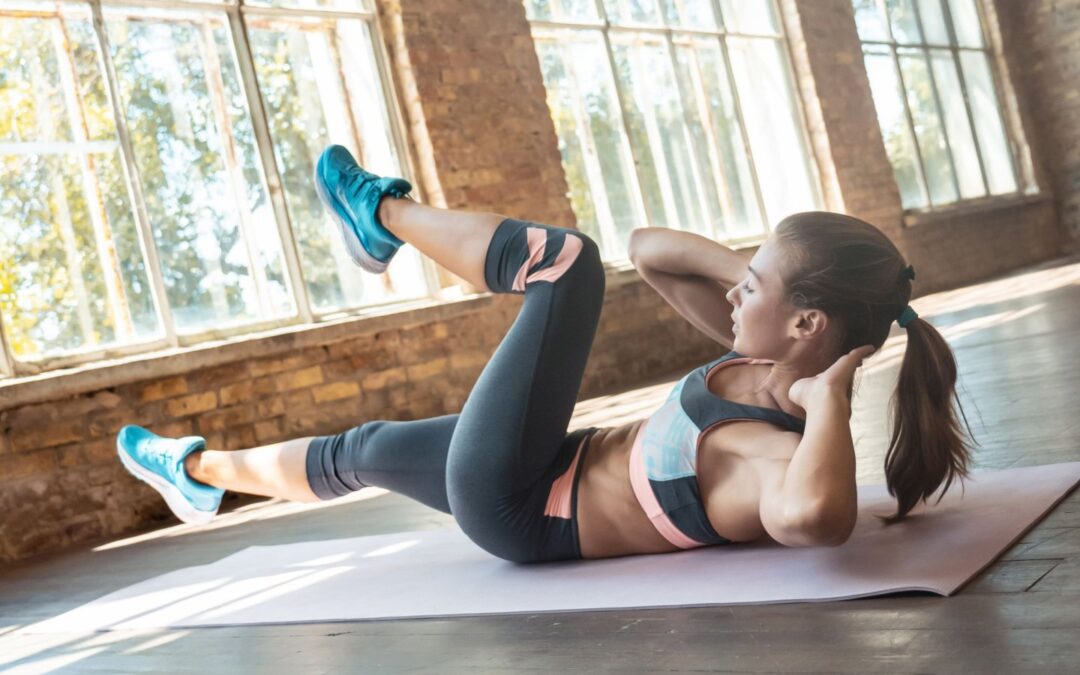Ab workouts are one of the few types of exercise that some people are instinctively drawn to whether they’re dedicated lifters or not. Many people use ab exercises as an entry point into some type of regular exercise, which is great. Hopefully they eventually move on to incorporate training their other body parts, but a start is a start.
Whether it’s performing crunches before breakfast or sit-ups before bed, some people make consistent ab training a priority. Some even take it a step further and use progressively more challenging exercises, which is where the bicycle crunch often appears.
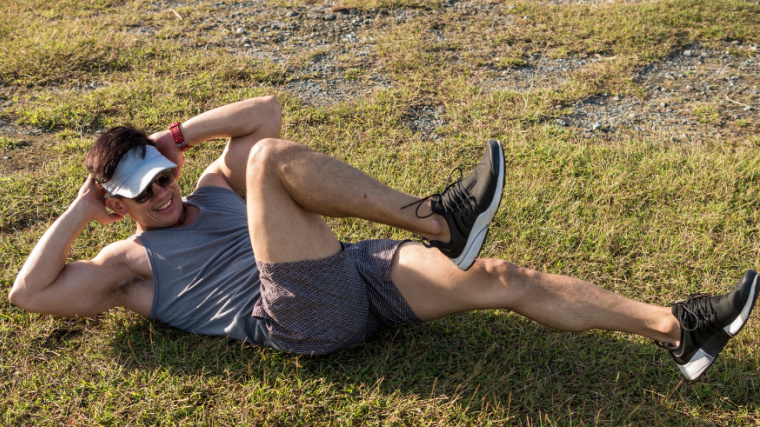
By combining a rotational upper body movement with lower body coordination, the bicycle crunch can effectively train your abdominals and oblique muscles in unison. This makes it an effective muscle-builder while also creating athletic core strength that can carry over to performance on the field, in the ring, or on the lifting platform. Here’s how to get the most out of this complete core-builder.
Bicycle Crunch
- How to Do the Bicycle Crunch
- Bicycle Crunch Mistakes to Avoid
- How to Progress the Bicycle Crunch
- Benefits of the Bicycle Crunch
- Muscles Worked by the Bicycle Crunch
- How to Program the Bicycle Crunch
- Bicycle Crunch Variations
- Frequently Asked Questions
How to Do the Bicycle Crunch Step By Step
The bicycle crunch may look like it requires “pat your head and rub your stomach”-levels of total-body coordination, but it doesn’t. Break the exercise into its component parts and you can learn the technique.
Step 1 — Lie on the Ground

Lie face up on the ground with your legs bent at roughly 90-degrees. Your feet should be in the air with your toes pointed up. Rest your head on the ground and bring your hands to your ears. Let your fingertips barely touch your head behind your ears with your palms facing the ceiling.
This is a familiar setup for many ground-based ab exercises whether it’s a full sit-up, crunch, or any related variation. Some exercises would have your feet planted flat on the ground, but the bicycle crunch requires your legs to begin in the air.
Form Tip: Don’t interlock your fingers and cradle the back of your head. This would put you in position to unconsciously crank your neck to complete repetitions. Your fingers should lightly touch the sides of your head or your ears.
Step 2 — Pedal the Bike
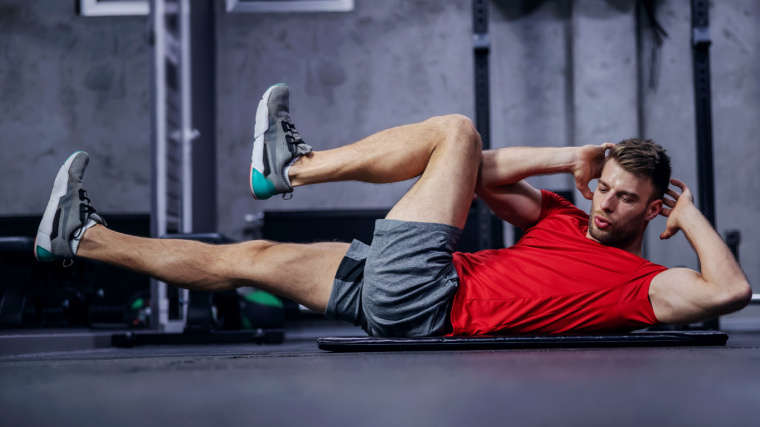
The bicycle crunch gets its descriptive name from the lower body action that appears similar to riding a bike. Contract your core muscles to raise both shoulders slightly off the ground. As your torso comes up, bring your left leg up and in toward your upper body.
At the same time, “crunch” your upper body forward and lean your right side toward the approaching leg. The range of motion will be relatively short, so focus on bringing the opposite sides together.
Don’t overfocus on reaching your elbow to your knee. That can lead to flapping your arms with reduced core activation. Instead, think about bringing one shoulder toward the opposite knee even though they don’t need to actually touch at the top of the movement.
Form Tip: Visualize an X-shaped band across the front of your body. As you move, think about each line drawing one leg and the opposite shoulder closer together.
Step 3 — Repeat the Rhythm
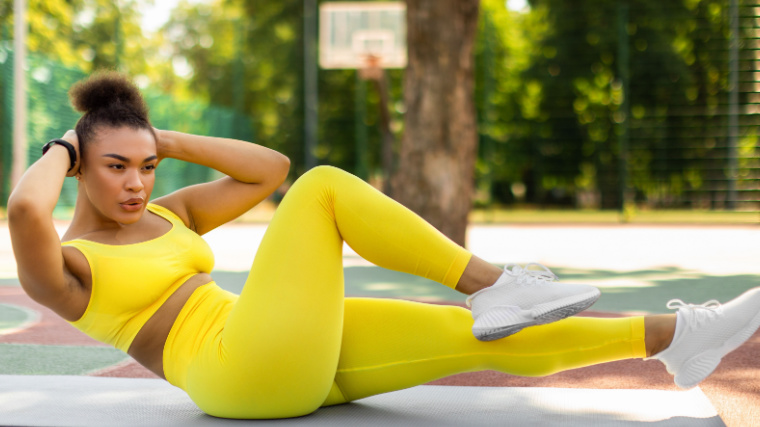
After a strong contraction at the top, extend your left leg forward while lowering your upper body to the floor. When your shoulders are on the ground and your leg is returned to the starting position, smoothly transition to repeat the movement with the other side.
Draw your right leg toward your torso while crunching your upper body forward and leaning the left side of your body into the approaching leg. As you complete multiple repetitions, alternating sides with each rep, you may eventually find a natural rhythm not unlike the rhythm needed to pedal a bike smoothly.
Form Tip: Perform each repetition slowly at first. Focus on the cross-body activation and core recruitment. As you become more comfortable with the movement, gradually increase the speed without sacrificing the quality of individual reps.
Bicycle Crunch Mistakes to Avoid
Because the bicycle crunch involves your legs and torso working together, there are several opportunities for things to go wrong. Here are some big issues to watch out for.
Elbows Flapping
Some people misinterpret the cross-body action of bringing their legs and upper body together, and end up swinging their upper arms and elbows toward their knee instead of activating their abdominals.

This not only reduces the work done by your abs, but it may potentially strain your shoulders or neck. Keep the movement strict, maintain focus on feeling your abdominals working to crate the movement, and don’t make it a priority to force your elbow and knee to touch in the middle of your body.
Avoid it: Keep your hands very lightly against your head, which will make any shoulder or elbow movement more noticeable. As you crunch, keep your elbows “back” nearly in line with your ears. Don’t allow them to point forward.
Shoulders Stay in the Air
One bad habit some people develop when performing high-rep sets of bicycle crunches is holding an ab contraction, remaining in the top of a crunch position, while “pedaling” their legs and explosively rotating their shoulders back and forth.
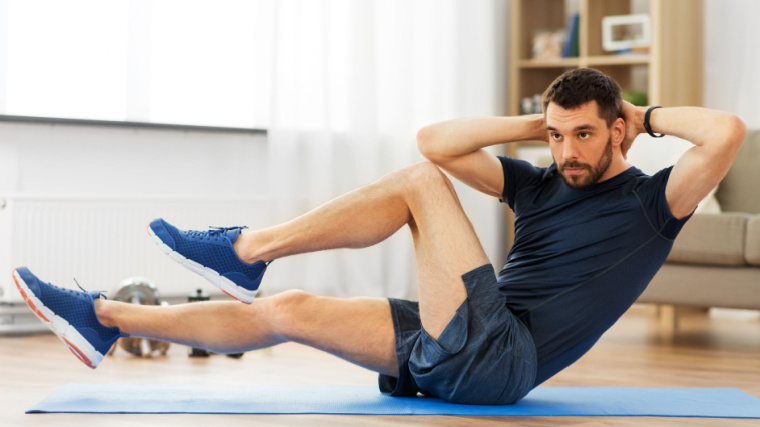
While this may potentially increase some work for your oblique muscles, you’re short-changing your abdominals because you’re holding a static contraction instead of working through a range of motion.
Avoid it: Treat each phase of the movement as separate parts — crunch and twist in one direction, lower fully, crunch and twist to the opposite side, lower fully again, repeat. Don’t try to rush through the set by completing reps as quickly as possible.
Not Enough Leg Movement
The bicycle crunch requires you to drive one leg up with each repetition. Performing the upper body movement without also “operating” your lower body changes the exercise. Instead of a bicycle crunch, it becomes a relatively more basic twisting crunch.
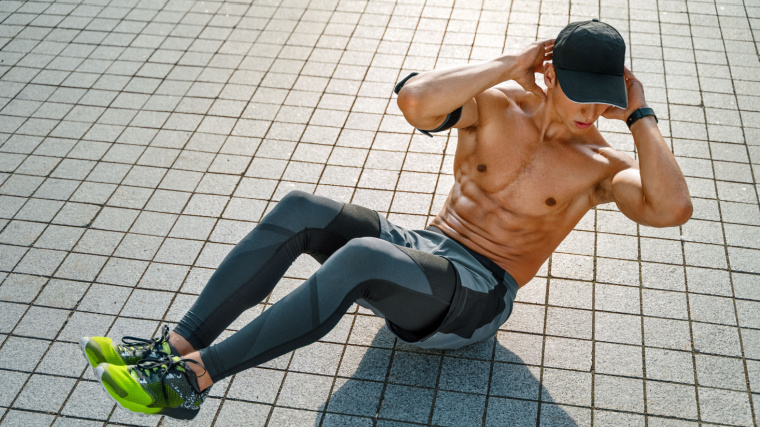
This can be an effective exercise on its own merit, but it doesn’t offer the same lower ab and hip flexor recruitment of the bicycle crunch. (1) If you begin a set intending to get the benefits of the bicycle crunch, make sure that’s the movement you end up performing.
Avoid it: If your legs aren’t moving, you’re not performing a bicycle crunch. With each repetition, draw your leg in toward your upper body and extend it as the opposite side moves.
How to Progress the Bicycle Crunch
Even though it’s a bodyweight exercise, the bicycle crunch can be considered relatively advanced because you’re operating your upper and lower body together. Work up to the full movement by mastering these foundational movements.
Crunch
Arguably the most fundamental ab exercise of all time, the basic floor crunch is an essential movement to be familiar with. The crunch offers lower body stability, with your feet firmly on the ground. The movement also lets you zone-in on creating a strong abdominal contraction over a short range of motion.
Standard floor crunch
Be sure not to turn the crunch into a full sit-up by raising your torso too high. The sit-up can also be an effective exercise but it won’t carry over as directly when building to a bicycle crunch.
Twisting Crunch
As mentioned earlier, failing to properly incorporate your legs into the exercise turns the bicycle crunch into a twisting crunch. However, you can flip that situation around by deliberately performing the twisting crunch as a way to build up core strength for the more advanced bicycle crunch.
Body Weight Exercise – Twisting crunch
By learning how to crunch “up and over,” you’re recruiting your obliques and abdominals into a single movement. When you become comfortable and capable with the twisting crunch, add the alternating leg movement to evolve the exercise into the bicycle crunch.
Benefits of the Bicycle Crunch
The bicycle crunch recruits your entire core by involving your upper body and lower body with rotational movement. This makes it a versatile and effective exercise for many fundamental goals.
Core Strength
Athletes in traditional sports, strength sports athletes, and recreational lifters can all benefit from a stronger core. Core strength has also been shown to help reduce lower back pain. (2)
The bicycle crunch can be an efficient addition to a comprehensive core-strengthening routine. The exercise works upper and lower body coordination and strength transfer, while also activating the obliques, which can play a major role in many athletic movements from running to throwing.
Ab Muscle Development
The upper abdominals are recruited in many ab exercises, but the lower abs are only heavily activated when the hips and lower body are involved in a given movement. The bicycle crunch achieves this increased muscle activation through repetitive leg movement.
The twisting motion of the torso also activates the oblique muscles, which are strongly recruited during rotational movements. Because it maximizes activation of several different ab muscles, the bicycle crunch is a very comprehensive bodyweight ab exercise.
Muscles Worked by the Bicycle Crunch
Most ab exercises, as expected, train your abs. The bicycle crunch kicks it up a notch by involving rotational movement which also recruits the obliques on the sides of your abs.
Abdominals
Your abdominals, or rectus abdominis, run along the front of your torso from the bottom of your chest to your hips. The abdominals are technically one single muscle with various muscle insertions, which means the muscle needs to be trained with a variety of movements for complete development. (3)
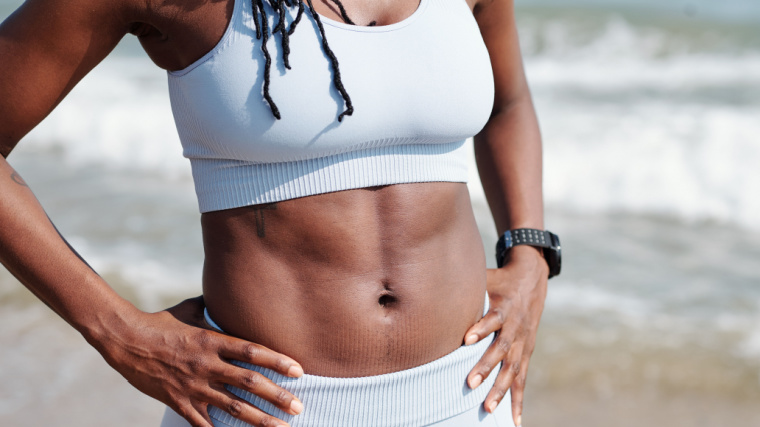
Essentially, movements focused on curling the trunk with a stable lower body will emphasize the “upper” portion of the abs while movements that emphasize curling the hips with a stable upper body, such as a reverse crunch, are more effective at recruiting the “lower” section of the muscle.
Obliques
The obliques are a pair of muscles on either side of your abdominals, near your hips. Your obliques primarily work to rotate your torso, as well as resist rotation. The oblique muscles are also activated side side flexion — bringing your shoulder closer to your hip in a sideways motion.
During the bicycle crunch, your obliques are strongly recruited as your torso twists in the direction of your approaching leg. So-called “love handles” are typically body fat that your genetics have decided to store near your oblique muscles. Contrary to popular myth, training your oblique muscles will not create love handles.
How to Program the Bicycle Crunch
As an efficient ab exercise, the bicycle crunch can find a home in any well-planned ab workout. Here are a few guidelines to get even more benefit.
Unweighted, Moderate to High Repetition
The nature of the bicycle crunch movement doesn’t lend itself to adding external resistance. Wearing a weighted vest can impede torso rotation and adding leg weights will excessively fatigue your smaller hip flexor muscles before targeting your ab muscles.
To get the most out of the exercise, use only your body weight as resistance and focus on achieving a strong muscular contraction with each repetition. Try completing two to four sets of 10 to 20 repetitions. Count once to each side as a side rep — left leg to right shoulder followed by right leg to left shoulder would be one single repetition, not two.
Bodyweight Circuit
Because the only “equipment” required to do the bicycle crunch is a clear section of floor, the exercise makes an efficient addition to a bodyweight exercise circuit (technically a workout complex, if all the exercises are bodyweight-only). For a quick and effective conditioning workout, try the following for three to five total circuits.
- Reverse Lunge — 10 reps per leg
- Push-up — 15 reps
- Bicycle crunch — 20 reps
Bicycle Crunch Variations
Whether you’ve mastered the bicycle crunch or need another complete core-building exercise to complement it, here are some of the most similar movements.
Hanging Scissor Kick
The scissor kick is a hanging leg raise variation. It involves dynamic action, alternating your legs with each repetition. Even though your upper body isn’t actively involved in performing a crunch, you can still benefit from a cross-body movement — especially if you “angle” your kick slightly toward your opposite shoulder.
Hanging Scissor Kicks
Don’t let your grip strength limit performance. If necessary, use lifting straps to secure yourself to the overhead bar. The exercise can also be done with your elbows supported at a “Captain’s chair” knee raise station.
Cable Woodchop
The cable woodchop, specifically the high-to-low variation, strongly recruits your obliques with stabilization assistance from your abdominals. Your lower body provides a stable base, while pivoting on your feet creates a strong transfer of power for greater athletic carryover.
Cable Woodchop (High to Low)
The low-to-high woodchop variation could be used for variety, but may excessively recruit your shoulder muscles. The low-to-high movement also requires less ab and oblique involvement in exchange for more lower and upper back activation.
Dead Bug
The dead bug may have one of the most visually descriptive exercise names of all time, but it’s also an underrated movement for core strength. It appears similar to be a “slow motion bicycle crunch” due to the cross-body movement and arm/leg coordination.
Dead Bug Exercise
One key to getting the most from the dead bug is to keep your lower back flat on the ground. If your lower back arches, you significantly reduce the core strength benefits. To stay focused on your lower back position, be sure to move slowly and deliberately, unlike the often more fast-paced bicycle crunch.
FAQs
Will doing the bicycle crunch every day give me a six-pack?
Sorry, but no. Doing any kind of ab exercise will not, on its own, give you a defined set of abs. However, it can be one part of the process. For maximum results, you need to pair ab training with a well-designed program that trains your entire body.
More importantly, you need to be following a calorie-controlled nutrition plan that’s designed to burn fat. You can train all you want and follow the “perfect” fat loss workout, but without a strict diet, you won’t see the results you’re after.
How many ab exercises should I do in each workout?
This depends on your overall training program. If you have one workout per week dedicated to training abs, you might be able to fit in four of five exercises — preferably targeting a range of different movements and muscle sections.
If you’re adding abs into a larger session like a shoulder workout or arm day, one or two exercises should be plenty. Because the bicycle crunch works your entire abs and obliques in one-go, it’s an excellent choice for this approach.
References
- Sarti, M. A., Monfort, M., Fuster, M. A., & Villaplana, L. A. (1996). Muscle activity in upper and lower rectus abdominus during abdominal exercises. Archives of physical medicine and rehabilitation, 77(12), 1293–1297. https://doi.org/10.1016/s0003-9993(96)90195-1
- Smrcina, Z., Woelfel, S., & Burcal, C. (2022). A Systematic Review of the Effectiveness of Core Stability Exercises in Patients with Non-Specific Low Back Pain. International journal of sports physical therapy, 17(5), 766–774. https://doi.org/10.26603/001c.37251
- Escamilla, R. F., Lewis, C., Bell, D., Bramblet, G., Daffron, J., Lambert, S., Pecson, A., Imamura, R., Paulos, L., & Andrews, J. R. (2010). Core muscle activation during Swiss ball and traditional abdominal exercises. The Journal of orthopaedic and sports physical therapy, 40(5), 265–276. https://doi.org/10.2519/jospt.2010.3073
Featured Image: Ground Picture / Shutterstock

